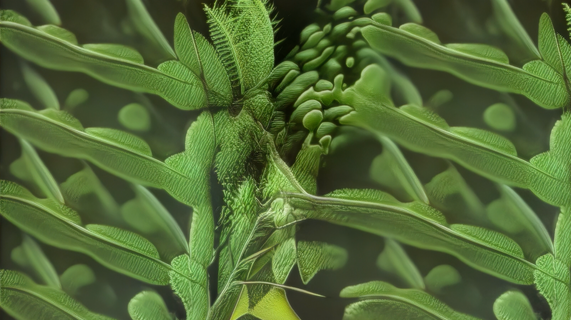Aerial views of forests, residential city streets, internal cellular structures, and the tension of raw muscles — all of these images blur together in Ivona Tau’s GAN AI video, After Us (After Nondescriptives), a 50-second perfect loop.
The abstracted forms at the work’s opening morph into branches and leaves before transforming into the glass and steel storefronts of city streets. It is in this trek through the uncanny valley that Tau finds her aesthetic, drawn from analogue photography. We watch the construction of landscapes dissolve and regenerate. The morphing animation shows a constant destruction of nature and infrastructure, signalling the simultaneous destruction of the natural world and the creation of the digital one.
I was curious to see how AI could generate images that are not easily described by text alone, capturing those that live between easily representative concepts.
Though her final works are often generated by AI models, Tau’s process begins with her photographic practice. Since picking up her grandfather’s Lomo LC-A camera, photography has been central to Tau’s work as she trains GAN models on her own photographs. By integrating an analogue practice into her generative work, Tau explores the many ways a machine can facilitate artistic creation.
The influence of photography is also present in the content of her work, as the medium is intrinsically tied to rapid western industrialisation. The camera plays a crucial role in discussions about the role of the machine in the modern era and as a tool that serves as an extension of the artist. The camera, much like the X-ray and the microscope, enables us to see beyond the naked eye, into the invisible understructures of our world.
Images: 1: Still from ‘Dominoes in Fluxus’, 2: Still from ‘Dominoes in Fluxus’, 3: Still from ‘Dominoes in Fluxus’. All images courtesy of the artist.
Since the advent of photography, its medium-specific combination of science and artistry has been crucial in shaping our understanding of the world. Prolific nature photographer Ansel Adams wrote in his 1950s guides on photography that the photographer’s camera settings and their emotional intent are equally weighted in the creation of their work. The photographer, like the generative artist, balances random chance with technical skill and expressional intent.
And though we may imagine Adams’ photographs as capturing pristine, uncurated nature, in the era of the anthropocene, there is no such thing as a landscape untouched by man. Every photograph is manipulated by the settings of the camera, and any subject it captures has been impacted by humans. Tau’s work acknowledges this confluence of the natural and the man-made, oscillating between landscapes and cityscapes, the hyper-realistic and the hyper-surrealist.
But whereas the 20th-century debate around the role of the machine questioned its role as vehicles for the augmentation of the man-made, Tau’s work imagines our surroundings in the context of the digital. The generation of recognisable settings in her work reflects the digitisation of the everyday. Unlike the 20th-century imagination of the bionic man, Tau’s work imagines a completely digital realm where the human must integrate into the rules of the machine.
Images: 1: ‘Mythic Latent Glitches’, 2: ‘Mythic Latent Glitches’, 3: ‘Mythic Latent Glitches’. All images courtesy of the artist.
The piece raises questions about beginnings, endings, and what might happen after our civilisation is overcome. Will urban architecture be reclaimed by nature? What will nature look like in thousands or millions of years?
After Us is yet another step removed from the analogue. Rather than starting with her own images, Tau uses a text-to-image generation and an AI model trained on her own urban nighttime photography. The result follows on from her 2022 Nondescriptives project of generated still images, adding sound and animation. By animating these still images, the topological distinctions between nature and man-made architecture becomes slippery and undetermined, forming a surreal landscape in constant flux. Tau’s use of synthetic inputs alongside her own data allows her to explore the concept of maintaining a cohesive style. Essentially, After Us is a collaboration between the machine and the artist’s previous body of work, a phenomenon unique to post-internet art.
Tau’s work takes its visual language from the world of video game graphics, this being both a feature of the code and reflective of human involvement in digital artwork. Much like video games, her work actively engages the viewer, ensuring that the human presence is felt despite being absent from each scene. After Us contemplates human experience at the intersection of the analogue and the digital, crafting an alternative reality that is simultaneously familiar and disorientating.
Images: 1: Still from ‘After Us (After Nondescriptives)’, 2: ‘After Us (After Nondescriptives)’, 3: ‘After Us (After Nondescriptives)’. All images courtesy of the artist.
INTERVIEW
Cycles of Evolution: How Ivona Tau Turns Cities Into Forests
Continuing Unit Digital’s series Beyond the Code, we speak with artist Ivona Tau about transforming code into cyclical narratives and creating visual outputs so rich they feel practically tangible.
Get in touch for additional information and to receive updates on future ‘Beyond the Code’ projects.
Biography
Ivona Tau is a generative AI artist, who’s work combines code, deep neural networks, and personal memories embedded in photography. Her goal is to evoke emotions through artificially intelligent tools. She has been actively researching AI and holds a PhD in Computer Vision, from the Multimedia Department at Polish-Japanese Academy of Information Technology.
Tau was elected as one of the TOP 10 Women in AI 2022 by Women in Tech foundation. Her work has been showcased and auctioned worldwide, at institutions including Sotheby’s New York, Christie’s New York, Fauves Paris, Duran Arte y Subastas, Ars Electronica Garden NYC, Stratosphere Beijing, Athens Digital Art Festival, CAFA, Bright Moments Berlin, Art Basel Miami and many more.





